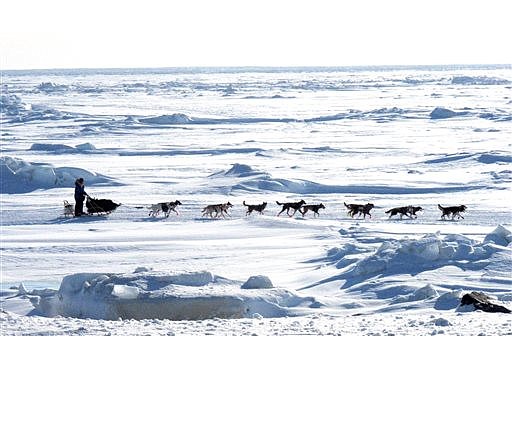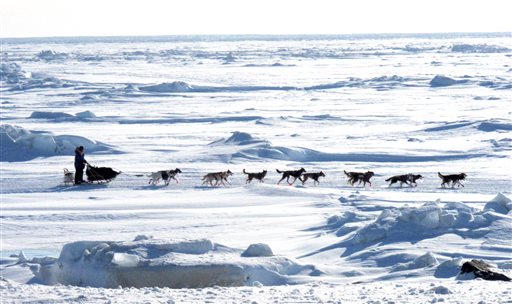Iditarod sled dog race kicks off this weekend
Friday, February 28, 2014
ANCHORAGE, Alaska - The Iditarod Trail Sled Dog Race across Alaska kicks off this weekend as usual, after warm winter weather nearly prompted officials to move the start hundreds of miles north to Fairbanks for the first time in a decade.
Temperatures have dropped, improving trail conditions and allowing the 42nd running of the world's most famous sled dog race to start as normal in Willow, about 50 miles north of Anchorage. The 1,000-mile race spans two mountain ranges, dangerous wilderness and the wind-whipped Bering Sea coast.
The ceremonial start, with a festival-type atmosphere, begins Saturday morning in downtown Anchorage. Mushers will take a leisurely 11-mile jaunt on sled dog trails within the state's largest city, with fans lining streets and urban trails to cheer on their favorites.
On Sunday, the race turns serious as mushers drive their dogs to Willow for the official restart. Sixty-nine racers are expected.
Besides crossing mountains, participants will mush on the mighty Yukon River and make the last push for Nome on dangerous sea ice as they travel up the Bering Sea shore. The winner is expected in about 10 days.
Defending champion Mitch Seavey said the changing conditions are nothing new, noting measurable rain fell on mushers last year. Another year, racers saw a 100-degree temperature swing, from minus 50 to 50 degrees above zero.
"It can be really anything, and I think that's one of the neat things about the race is that you need to be prepared for anything," Seavey said.
Concerns about the trail were in areas south of the Alaska Range and in the mountains themselves, race marshal Mark Nordman said. But snow and especially colder temperatures after a long January thaw have alleviated worries there and in areas such as the Yentna River.
"That's pretty much healed itself," Nordman said of the trail on the river.
Crews of up to 15 people have been working on the trail daily for the past month and a half, he said. They cut back brush, smoothed out moguls and created crossings over small streams by felling trees and piling snow on them.
The goal is to be the first musher to reach the finish line on Front Street, just off the Bering Sea, in the old Gold Rush town of Nome on Alaska's western coast. The winner receives $50,000 and a new pickup.
But the Iditarod is not without its critics. The organization People for the Ethical Treatment of Animals says 23 dogs have died in the race since 2004.
"Mushers are chasing money and glory, but in the 40 years since the first Iditarod race was held, not one dog has ever signed up to participate," Daphna Nachminovitch of PETA said in an email to The Associated Press. "Forty years of suffering and death are proof that the Iditarod will never be safe for dogs -it must be canceled permanently."
Seavey became the race's oldest musher last year at age 53.
"It's a new year, and I don't know if what happened last year makes much difference to what's going to happen this year, except I have a more recent winning team to work with, and most of those guys are returning," Seavey said.
He said he's taken his dogs to various parts of Alaska to give them experience in running in different conditions. Seavey, who also won the race in 2004, hopes that training "helps us with a more diverse foundation when race time comes."
His son, Dallas, won the race in 2012, becoming the Iditarod's youngest champion ever at age 25.
Dallas said an unknown in this year's race is the large number of Scandinavian mushers, including five Norwegians and one Swede.
"Those guys know how to run dogs," Dallas said. "And they may be new to the Iditarod, or have less Iditarod races under the belts, but they're not new to mushing.
"It's about dogmanship, and those guys know that game," he said.
Robert Sorlie, 56, of Hurdal, Norway, has been in the Iditarod four times and won twice, in 2003 and 2005. He's back after a six-year absence.
Also running separate teams are Allen Moore, who last month won his second consecutive Yukon Quest International Sled Dog Race, and his wife, Aily Zirkle, who finished second to both Seaveys in the last two years.
Scott Janssen, an Anchorage undertaker who is known as the Mushing Mortician, said he could name 28 people who easily could win this year's Iditarod.
"When I look at the front-runners, I want to be in the top 30," he said, but even that might be a daunting task.
One name will be missing from the starting field. Lance Mackey, a four-time champion, is sitting out this year due to health concerns and because he has young dogs.
Four mushers already have scratched, including Brent Sass of Eureka, Alaska. The 34-year-old Minnesota native suffered a concussion in the Yukon Quest when he fell off his sled and cracked his head on the ice about 100 miles from the finish in Whitehorse, Yukon.

